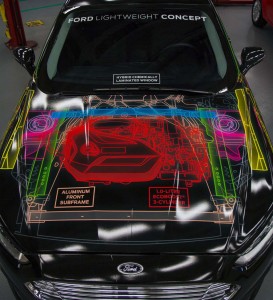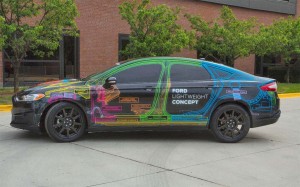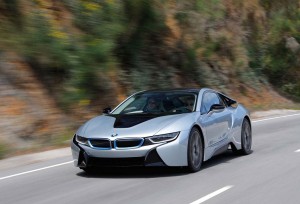When Ford’s new F-150 pickup comes to market later this year it will shed as much as 700 pounds, a move that is expected to yield significant improvements in both performance and fuel economy. And now, the automaker is hinting it has even more aggressive plans in mind for a future version of its popular midsize model, the Fusion.
The Detroit maker is showing off a new, super-light version of the sedan that makes use of aluminum and other materials to drop a full 800 pounds compared to the current Fusion. And though there are no immediate plans to put the prototype into production, it will influence future product development programs.
Part of Ford’s so-called Blueprint for Sustainability, the project reflects a growing focus on lightweighting, the auto industry’s way of saying that vehicles have to go on a diet if manufacturers hope to meet the tough new fuel economy standards coming into effect in the U.S. over the next decade, as well as stiffer CO2 emissions rules in Europe. The good news for consumers is that by reducing weight a vehicle like the Fusion won’t necessarily have to be downsized to achieve significant improvements in mileage.
“The Lightweight Concept gives us the platform to explore the right mix of materials and applications for future vehicles,” said Matt Zaluzec, Ford’s technical leader for global materials and manufacturing research.
(Click Here to check out the radical dart-shaped Deltawing 4-seater.)

This images shows some of the additional changes - such as the use of a smaller engine -- that lightweighting permits.
Smart design can help put a car on a diet. Cadillac, for example, scalloped the edges of sheet metal panels used in the frame of its new ATS model to shave off a few pounds. Mazda has downsized the water pump on its new Mazda6 sedan and even trimmed a gram off the mass of each tire’s lug nuts. But some of the biggest savings are expected to come from adopting new lightweight materials that can replace traditional steel.
The 2015 Ford F-150, for example, migrates to an aluminum body. Developed with the help of Canadian mega-supplier Magna, and the U.S. Department of Energy, the new Lightweight Concept vehicle also opts for aluminum for much of its body and chassis.
But it also goes with other lightweight materials, such as the carbon fiber and nylon in its instrument panel and seat frame, as well as magnesium valves, and even polycarbonates and laminates to reduce some of its glass, including the rear window.
Trimming weight out of the body has a knock-on effect, as engineers like to say. Shave enough weight and you can then use a smaller engine – in this case, a modest 1.0-liter, 3-cylinder engine — brakes and suspension components.
The cost isn’t cheap, Ford stressed, in explanation of why it won’t rush to use the Lightweight Concept as a near-term replacement for the popular Fusion model. The carbon fiber seat frame, for example, might be 17% lighter than one made of steel, but it would cost as much as six times more than the $12 of a conventional seat structure.
The good news is that costs are coming down – enough to let the maker switch from steel to aluminum with the new F-150. Meanwhile, rival BMW is beginning to make more extensive use of super-light carbon fiber on a number of new models, including the i3 battery-electric vehicle and the i8 plug-in hybrid sports car.
“We’re committed to carbon fiber in a big way,” Paul Ferraiolo, U.S. product chief for the i8 program, told TheDetroitBureau.com.
The German maker is so committed that it has entered into an extensive research and manufacturing partnership aimed at driving down the cost of the material and speeding up its production rate. It recently announced plans to triple the output of a carbon fiber plant in Washington State that will soon by the largest factory of its kind in the world.
(For more on that project, Click Here.)
Ford plans to put the new Lightweight Concept through extensive testing over the next couple years to see how the various new materials can hold up. That could lead to real-world applications to follow.
(Click Hereto find out why Hyundai-Kia was named the “greenest” automaker, toppling long-time leader Honda.)
But the maker has to move fast. According to the latest annual Trends Report from the Environmental Protection Agency, the auto industry boosted the fuel economy of its typical vehicle by 11 mpg from 1975 to 2013. But it will have to achieve an even bigger gain, mileage expected to jump by roughly 50% between now and 2025, when the new Corporate Average Fuel Economy will rise to 54.5 mpg.
Lightweighting alone won’t get there. Industry experts anticipate future vehicles will make more extensive use of hybrid power and other new technologies, as well as improved aerodynamics. But lightweighting will be critical. On average, every 100 pounds of weight that’s shed yields about a 1 mpg improvement. So if the future Ford Fusion were to lose 800 pounds it would go a long way to meeting those tough 2025 mileage regulations.



Developing lighter autos has never been an issue. Cost is the issue. If people are willing to pay more then lighter, more expensive materials can be used.